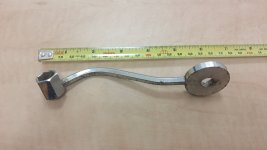Red_desert
Gold Member
- Feb 21, 2008
- 6,855
- 3,506
- Detector(s) used
- Garrett Ace 250/GTA 1,000; Fisher Gold Bug-2; Gemini-3; Unique Design L-Rods
- Primary Interest:
- All Treasure Hunting
There is an indigenous tribe which owns land also. Interesting, the natives here look as light skinned as the Cherokee nation. Years ago, it was possible to meet with the chief by way of a primitive landing strip. Don Martin told me he did that once, had to wait for chief during an all-day ceremony. You make it through the tribal ritual, chief then will talk to you about permission to prospect for gold. I never could have guessed that Don was part Cherokee until his brother living on the Oklahoma reservation helped him get a card. Technically, Cherokee Nation OK is not a federal reservation because they own the land.

"Para state, Brazil Munduruku Indian warriors stand guard over an illegal gold miner who was detained by a group of warriors searching out illegal gold mines and miners in their territory near the Caburua river, a tributary of the Tapajos and Amazon rivers in western Para state, on Jan. 20, 2014."
"Para state, Brazil Munduruku Indian warriors stand guard over an illegal gold miner who was detained by a group of warriors searching out illegal gold mines and miners in their territory near the Caburua river, a tributary of the Tapajos and Amazon rivers in western Para state, on Jan. 20, 2014."
Last edited:



